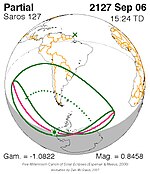Solar eclipse of April 16, 1893
| Solar eclipse of April 16, 1893 | |
|---|---|
| Type of eclipse | |
| Nature | Total |
| Gamma | −0.1764 |
| Magnitude | 1.0556 |
| Maximum eclipse | |
| Duration | 287 s (4 min 47 s) |
| Coordinates | 1°18′N 34°36′W / 1.3°N 34.6°W |
| Max. width of band | 186 km (116 mi) |
| Times (UTC) | |
| Greatest eclipse | 14:36:11 |
| References | |
| Saros | 127 (51 of 82) |
| Catalog # (SE5000) | 9264 |
A total solar eclipse occurred on April 16, 1893. A solar eclipse occurs when the Moon passes between Earth and the Sun, thereby totally or partly obscuring the image of the Sun for a viewer on Earth. A total solar eclipse occurs when the Moon's apparent diameter is larger than the Sun's, blocking all direct sunlight, turning day into darkness. Totality occurs in a narrow path across Earth's surface, with the partial solar eclipse visible over a surrounding region thousands of kilometres wide.
Observations
Schaeberle observed the eclipse and made drawings of the Corona:
 Predicted by Schaeberle |
 Observed by Schaeberle |
 Observed by Schaeberle |
According to Edward S. Holden, John Martin Schaeberle discovered a comet like object on the plates of the eclipse from Chili. The comet was 0.8 moondiameters from the moon.[1]
Related eclipses
Saros 127
This eclipse is a part of Saros series 127, repeating every 18 years, 11 days, and containing 82 events. The series started with a partial solar eclipse on October 10, 991 AD. It contains total eclipses from May 14, 1352 through August 15, 2091. There are no annular or hybrid eclipses in this set. The series ends at member 82 as a partial eclipse on March 21, 2452. Its eclipses are tabulated in three columns; every third eclipse in the same column is one exeligmos apart, so they all cast shadows over approximately the same parts of the Earth.
The longest duration of totality was produced by member 31 at 5 minutes, 40 seconds on August 30, 1532. All eclipses in this series occur at the Moon’s ascending node of orbit.[2]
| Series members 46–68 occur between 1801 and 2200: | ||
|---|---|---|
| 46 | 47 | 48 |
 February 21, 1803 |
 March 4, 1821 |
 March 15, 1839 |
| 49 | 50 | 51 |
 March 25, 1857 |
 April 6, 1875 |
 April 16, 1893 |
| 52 | 53 | 54 |
 April 28, 1911 |
 May 9, 1929 |
 May 20, 1947 |
| 55 | 56 | 57 |
 May 30, 1965 |
 June 11, 1983 |
 June 21, 2001 |
| 58 | 59 | 60 |
 July 2, 2019 |
 July 13, 2037 |
 July 24, 2055 |
| 61 | 62 | 63 |
 August 3, 2073 |
 August 15, 2091 |
 August 26, 2109 |
| 64 | 65 | 66 |
 September 6, 2127 |
 September 16, 2145 |
 September 28, 2163 |
| 67 | 68 | |
 October 8, 2181 |
 October 19, 2199 | |
Notes
- ^ SENL200304 (PDF) at NASA.gov
- ^ "NASA - Catalog of Solar Eclipses of Saros 127". eclipse.gsfc.nasa.gov.
References
- NASA graphics
- Fotos of Solar Corona April 16, 1893
- [1],[2], [3] Eclipse of April 16, 1893. Contact print from the original glass plate negative.] Lick Observatory Plate Archive, Mt. Hamilton.
- Total Eclipses of the Sun, By Mabel Loomis Todd, 1894, new and revised edition by David P. Todd, 1900. [4]




